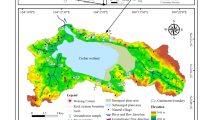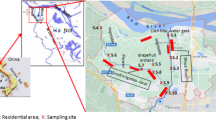Abstract
Isotopic signatures of δD-H2O, δ18O-H2O, δ15N-NO3−, δ18O-NO3− and δ15NFertilizer isotopes were used in order to evaluate the impact of agricultural inputs (fertilizers and calcium nitrate) and sewage effluents on the water of tributaries of the Faxinal Dam, which supply the city of Caxias do Sul in Southern Brazil. δ2H and δ18O were identified by spectroscopy laser absorption tunable diode-type cavity ring-down spectroscopy, while the isotopic ratios of 15N and 18O in nitrate were determined by isotopic ratio mass spectrometry, applying the chemical denitrification method. The results showed that most of the analyzed samples are compatible with the Global Meteoric Water Line, Local Meteoric Water Line and Carlos Barbosa Wells and Fountains Tendency Line, except for the Fx-07 sample that presented greater similarity to δ18O values for groundwater. The isotopic signatures of δ15N-NO3− versus δ18O-NO3−, in the great majority of the samples, pointed out the influence and the contribution of the fertilizers. In a monitored affluent, the results show the impact of the direct discharge of domestic sewage, while in the sewage treatment plant there is clear evidence of denitrification. This study demonstrated that isotope application of δ15N-NO3− and δ18O-NO3− is efficient tools for identification of N-NO3− of synthetic fertilizers and domestic sewage.
Similar content being viewed by others
References
Bortolin TA (2014) Padrões hidroquímicos e isotópicos do sistema aquífero Serra Geral no município de Carlos Barbosa, região nordeste do Estado do Rio Grande do Sul. Master’s Dissertation, Hydraulic Research Institute (UFRGS), Porto Alegre
BryantMason A, Xu JY, Altabet M (2012) Isotopic signature of nitrate in river waters of the lower Mississipi and its distributary, the Atchafalaya. Hydrol Proces. https://doi.org/10.1002/hyp.9420
Centro Estadual de Metereologia (CEMETRS) http://www.cemet.rs.gov.br/conteudo/3933/?5_-_Precipita%C3%A7%C3%A3o. Accessed 20 Aug 2014
Chang CCY, Kendall C, Silva SR, Battaglin WA, Campbell DH (2002) Nitrate stable isotopes: tools for determining nitrate sources among different land uses in the Mississippi River Basin. Can J Fish Aquat Sci 59(12):1874–1885
Cummings TF (2015) Assessment of nitrate export in agricultural sub-catchments of the Grand River Watershed: an isotope approach. Thesis requirement for the degree of Master in Science (Earth Sciences), University of Waterloo, Ontario, Canada
Dansgaard W (1964) Stable isotopes in precipitation. Tellus 16:436–468
Deutsch B, Mewes M, Liskow I, Voss M (2006) Quantification of diffuse nitrate inputs into a small river system using stable isotopes of oxygen and nitrogen in nitrate. Org Geochem 37(10):1333–1342
Gehle K (2015) Case studies in environmental medicine: nitrate/nitrite toxicity. Agency for Toxic Substances and Disease Registry—ATSDR. http://www.atsdr.cdc.gov/csem/csem.html. Accessed 15 Mar 2016)
IAEA/WMO (2001) Global network of isotopes in precipitation: the GNIP database. http://isohis.iaea.org. Accessed 10 Jan 2011)
Instituto Nacional de Metereologia (INMET) http://www.inmet.gov.br/portal/index.php?r=bdmep/bdmep. Accessed 20 Aug 2014
Jin Z, Pan Z, Jin M, Li F, Wan Y, Gu B (2012) Determination of nitrate contamination source using isotopic and chemical indicators in an agricultural region in China. Agric Ecosyst Environ 155:78–86
Kelley CJ, Keller CK, Evans RD, Orr CH, Smith JL, Harlow BA (2013) Nitrate-nitrogen and oxygen isotope ratios for identification of nitrate sources and dominant nitrogen cycle processes in tile-drained dryland agricultural field. Soil Biol Biochem 57:731–738
Kendall C, Elliott EM, Wankel SD (2007) Tracing anthropogenic inputs of nitrogen to ecosystems, Chapter 12. In: Michener RH, Lajtha K (eds) Stable isotopes in ecology and environmental science, 2nd edn. Blackwell Publishing, Hoboken
Lohse KA, Sanderman J, Amundson R (2013) Identifying sources and processes influencing nitrogen export to a small stream using dual isotopes of nitrate. Water Resour Res 49:5715–5731. https://doi.org/10.1002/wrcr.20439
McIlvin MR, Altabet MA (2005) Chemical conversion of nitrate and nitrite to nitrous oxide for nitrogen and oxygen isotopic analysis in freshwater and seawater. Anal Chem 77:5589–5595
Minet E, Coxon CE, Goodhue R, Richards KG, Kalin RM, Meier-Augenstein W (2012) Evaluating the utility of 15N and 18O isotope abundance analyses to identify nitrate source: a soil zone study. Water Res 46:3723–3736
Monforte RSM (2014) Adaptação do método de determinação do δ15N do íon nitrato em amostras de água superficial. Master’s Dissertation, University of Brasília/Institute of Chemistry
Roisenberg A, Viero AP (2000) O Vulcanismo Mesozóico da Bacia do Paraná no Rio Grande do Sul. In: Holz M, De Ros F (eds) Geologia do Rio Grande do Sul. Porto Alegre: CIGO/UFRGS Porto Alegre. 444p. il. CDU 55 (816.5)
Spoelstra J, Kralt BJ, Elgood RJ (2014) A chemical method for the conversion of nitrate to nitrous oxide for isotopic analysis. National Water Research Institute, Report Number 14-088. Environment Canada
Streck EV (2008) Solos do Rio Grande do Sul, 2nd ed. EMATER/RS-ASCAR, Porto Alegre
Vargas T, Adami MVD, Aver EAS, Belladona R, Zago MA, Frizzo EE (2013) Monitoramento Hidroquímico dos Córregos Afluentes da Represa Faxinal, Caxias do Sul - RS. In: XX Simpósio Brasileiro de Recursos Hídricos, Bento Gonçalves, Brasil
Wexler SK, Hiscock KM, Dennis PF (2012) Microbial and hydrological influences on nitrate isotopic composition in an agricultural lowland catchment. J Hydrol 468–469:85–93
Wood WW (2001) Water sustainability-science or management. Ground Water 39(5):641
World Health Organization (WHO) (2017) Guidelines for drinking-water quality: fourth edition incorporating the first addendum. Library Cataloguing-in-Publication Data. ISBN 978-92-4-154995-0
Acknowledgements
The authors thank the Municipal Autonomous Service of Water and Sewage of the city of Caxias do Sul for the great support for this research.
Author information
Authors and Affiliations
Corresponding author
Rights and permissions
About this article
Cite this article
De Vargas, T., Roisenberg, A. Nitrogen and oxygen isotopes as indicators of pollution sources in the Faxinal Dam watershed, Southern Brazil. Environ Earth Sci 77, 229 (2018). https://doi.org/10.1007/s12665-018-7395-5
Received:
Accepted:
Published:
DOI: https://doi.org/10.1007/s12665-018-7395-5










